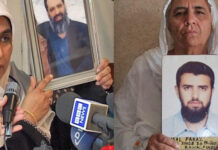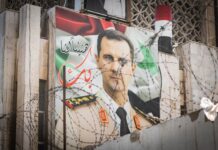Sri Lanka’s Muslim community has been under the spotlight in recent years due to Colombo’s discriminatory policies. In this feature, we take a look at the long history of Muslims in Sri Lanka which began in relative harmony but descended into Western colonial persecution and is now threatened by Buddhist nationalism.
Sri Lanka’s vibrant Muslim community number just under two million, around 9% of the total population, forming an integral part of the tear drop shaped island’s rich heritage and culture.
Islam came to the island in the 7th century CE soon after its establishment in the Arabian Peninsula. The first Muslims in Sri Lanka were Arab traders from Syria, Yemen and North Africa.
Incoming Muslims intermarried with local women who converted to Islam, settling along the coastline and dominating the overseas trade routes of spices and gems. South Indian Muslims with similar Arab ancestry also came to the island, and these two communities were later named the “Sri Lankan Moors” by Portuguese colonisers.
The first Muslim settlement was the town of Beruwala on the island’s southwestern coast, founded in the 8th century by Sheikh Yusuf bin Ahmad al-Kawneyn from Somalia who propagated Islam amongst the locals. The first mosque, Masjidul Ibrar Jumma, was built at Beruwala in 920 CE. Today the town retains a Muslim majority with many trading in gems just as their Arab ancestors did.
The Muslims were highly valued by the Sri Lankan Buddhist kings during the Anuradhapura and Kandyan periods (9th to 19th century). Being masters of the spice and gem trades as well as several languages, their counsel was sought on foreign affairs and trade.
The Muslims of Sri Lanka by Lorna Dewarajee states:
Subscribe to our newsletter and stay updated on the latest news and updates from around the Muslim world!
“The Muslim trader with his navigational skills and overseas contacts became the secret channel of communication between the court and the outside world. The Sri Lankan kings encouraged the Muslims to maintain their links with the Islamic world as this was mutually beneficial. In the 13th century, Al Haj Aby Uthman was sent by the Sri Lankan king, Bhuvanekabahu I to the Mamluk Court of Egypt to negotiate direct trade. They were sent on important and confidential missions to South India right up to Kandyan times”
Religious persecution and expulsion by the Portuguese
But the arrival of Portuguese colonisers in 1505 heralded a dark age of persecution for the Muslims.
The Portuguese harboured a deep hatred of Muslims, a sort of medieval Islamophobia. Arab Muslims ruled Portugal – known then as Gharb Al-Andalus (west of Andalus) – from the 8th to 12th centuries CE. But the Portuguese Reconquista ended their reign in 1249 when most Portuguese Muslims were either killed, converted to Catholicism or fled. Those remaining were finally expelled in 1496 by Manuel I, only a decade before the Portuguese came to Sri Lanka.
Portuguese colonisation was characterised by its exploitation of political divisions between the Buddhist Sinhalese Kings, the takeover of the island’s lucrative cinnamon trade and proselytising the Catholic faith.
Intense missionary activity took place – whole villages were converted and the enticement of money lay behind the many baptisms amongst the Sinhalese aristocracy. In 1567 the Clergy Council of Goa forbade the calling of Prophet Muhammad’s (pbuh) name and the recital of the Holy Quran and ordered the arson of places of worship and the handing over of premises and property to the Christian Churches. Several massacres of thousands of Muslims took place in the towns of Matara, Weligama, Beruwela and Galle.
The Muslims – after many defeats often fighting alongside Sinhalese rulers – eventually reconciled themselves to Portuguese military superiority, building cordial relations to bolster trade. The Portuguese in turn needed Muslim expertise in commerce and a fragile peace emerged.
However, it did not last long. In 1626 the Portuguese King Philip IV ordered the expulsion of Muslims from the island. Now refugees, some left while 4,000 were offered protection by King Senerath of Kandy who gave them refuge in the eastern province of Batticaloa. Many eventually made their way back to the island whilst some concealed their Muslim identity or remained in hiding.
Discrimination and economic hardship under the Dutch
The emergence of Dutch colonial rule came about as the Kingdom of Kandy sought Dutch support in removing the Portuguese. The costs of liberation meant the Dutch gained control of the island’s exports and some of its territories. Subsequently, the Dutch enacted discriminatory laws designed to destroy any Muslim involvement in commerce, intended to cause such severe economic hardship that Muslims would be forced to leave Sri Lanka permanently.
Muslims were not permitted to live in the important trading towns of Galle, Matara and Weligama nor could they take part in any form of trade. In 1665 the sale of Dutch land to Muslims was banned and a controversial census made it compulsory for every Muslim to register their faith with a threat of banishment for non-compliance.
According to a translation of the instructions from the Governor General and Council of India to the Governor of Ceylon 1656-1665:
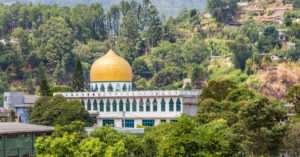
“Only agriculture and navigation must be left open to them as occupations and they are prohibited from engaging in all other trades, within this country, either directly or indirectly and with a view to gradually exterminate this impudent class of people. Their Honours have prohibited any increase to their numbers from outside. The Dessave must not permit the Moors to perform any religious rites nor tolerate their priests ….
“Your Honour must see that the Moor and Muhammadan subjects of the Company receive less favour than the Christians and heathen and that they are never allowed to occupy positions of superiority over the Christians but that they are rather opposed in every way, so as to prevent this objectionable community spreading in our midst.”
The Muslims circumvented these laws and by conducting trade as middlemen between the Sinhalese and the Dutch exporters so they effectively continued to control a portion of the export market and sustained themselves.
And despite the Dutch targeting Muslims it must also be remembered that they brought the next wave of Muslim migration – ethnic Muslim Malays – to the island. They were soldiers employed by the Dutch as well as exiled nobles from the Dutch territories in South East Asia.
The British era: Divide and rule
The British arrived on the island at the end of the 18th century at the request of the Kandyan King to end Dutch rule.
The British exploited divisions between the Sinhalese kings to gain control of the entire island in 1815. The abolition of the poll tax on Muslims imposed by the Dutch, which Governor North described as “an oppressive and disgraceful tax on an industrious race,” was motivated not by moral outrage but the desire to win Muslim allies to undermine the Kandyan kingdom.
The British favoured those who spoke English and were educated at Christian missionary run schools. Jobs in government service and teaching were only offered to English speakers meaning Christians, Burghers and upper class Tamils were favoured over other communities as the Muslims and the Sinhalese did not want their children to be educated in an alien faith.
In 1833 the Ceylon Legislative Council (a form of national government) was established and included three seats for what the British termed the native inhabitants of the island – the Tamils, the Sinhalese and the Burghers (those of mixed European descent).
The British policy of political representation on the grounds of race had lasting effects on the Muslim community who were effectively “othered,” only receiving a seat in 1889 after fervent protests. Although they fared better under British rule compared to their colonial predecessors, Muslims were not favoured in the “racial hierarchy.” The ideas of ethno nationalism sowed by the British continue to fuel communalism today.
Civil war
After Sri Lanka’s gained its independence from the British civil war eventually broke out between the majority Buddhist Sinhalese and the minority Tamil Hindus who wanted their own separate state in the north and the east. The bloody conflict would last from 1983 to 2009 when the Sinhalese won a decisive victory.
Muslims paid the price for their non-violence and avoidance of Tamil militancy. In the conflict-affected north and east they were killed, ethnically cleansed, abducted and displaced from their homes.
At the end of the armed conflict they became the “new enemy” to both Sinhalese and Tamils. They were targeted by Sinhalese Buddhist extremist groups (operating with tacit government support) in systematic and widescale violent attacks and hate campaigns on social media.
Despite a long history of mostly peaceful co-existence between the Sinhalese and Muslims, the recent rise of Buddhist nationalism has fuelled Islamophobia on the island. Extremist Buddhist groups such as the Bodhu Bala Sena (BBS or Buddhist Power Force) have campaigned against halal certification and for a ban on the burqa and the abaya (long Muslim dress) with the support of Buddhist monks who espouse anti-Muslim sentiments.
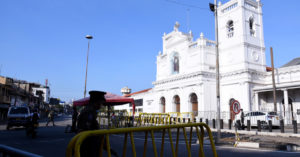
Editorial credit: Ruwan Walpola / Shutterstock.com
Venerable Ambalangoda Sumedhananda Thero, a Buddhist monk at the Gintota monastery, said:
“The aim of Muslims is to take over all our land and everything we value,”. “Think of what used to be Buddhist lands: Afghanistan, Pakistan, Kashmir, Indonesia. They have all been destroyed by Islam.”
In 2014 anti- Muslim rallies called by the BBS in Aluthgama led to the deaths of three Muslims, several more were injured and Muslim-owned businesses were looted and burnt down.
On April 21, 2019, suicide bombings blamed on “Muslim extremists” that took place in three churches and three hotels in Sri Lanka killed around 277 people and wounded more than 400. Subsequent to the attacks, incidents of ethnic violence and tension targeting the Muslim community occurred in several parts of the country.
The current president, Gotabaya Rajapaksa, is supported by Buddhist nationalists and in 2020 the government insisted on the forced cremation of Muslim Covid-19 victims, contrary to both the Islamic faith and World Health Organisation advice. A year long campaign by Sri Lanka’s Muslims and global efforts from the Muslim and international communities finally led to a reversal of the policy.
But in March 2021 a burqa ban, the prohibition of the import of Islamic books and the closing down of hundreds of madrasas (Islamic religious schools) was announced, causing renewed fear amongst the Muslim community.
Throughout history Sri Lanka’s Muslims have shown a quiet determination in the preservation of their faith and resilience in the face of discrimination. Today they face uncertainty which given their history is only likely to lead to a strengthened resolve to survive and thrive on the island they call home.







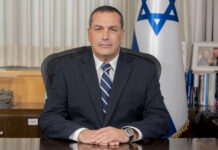
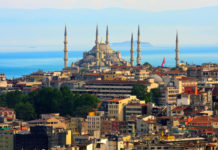

![24 Hour Road Trip Through Free Syria [Short Film]](https://5pillarsuk.com/wp-content/uploads/2025/02/IMG_5907-218x150.jpg)
